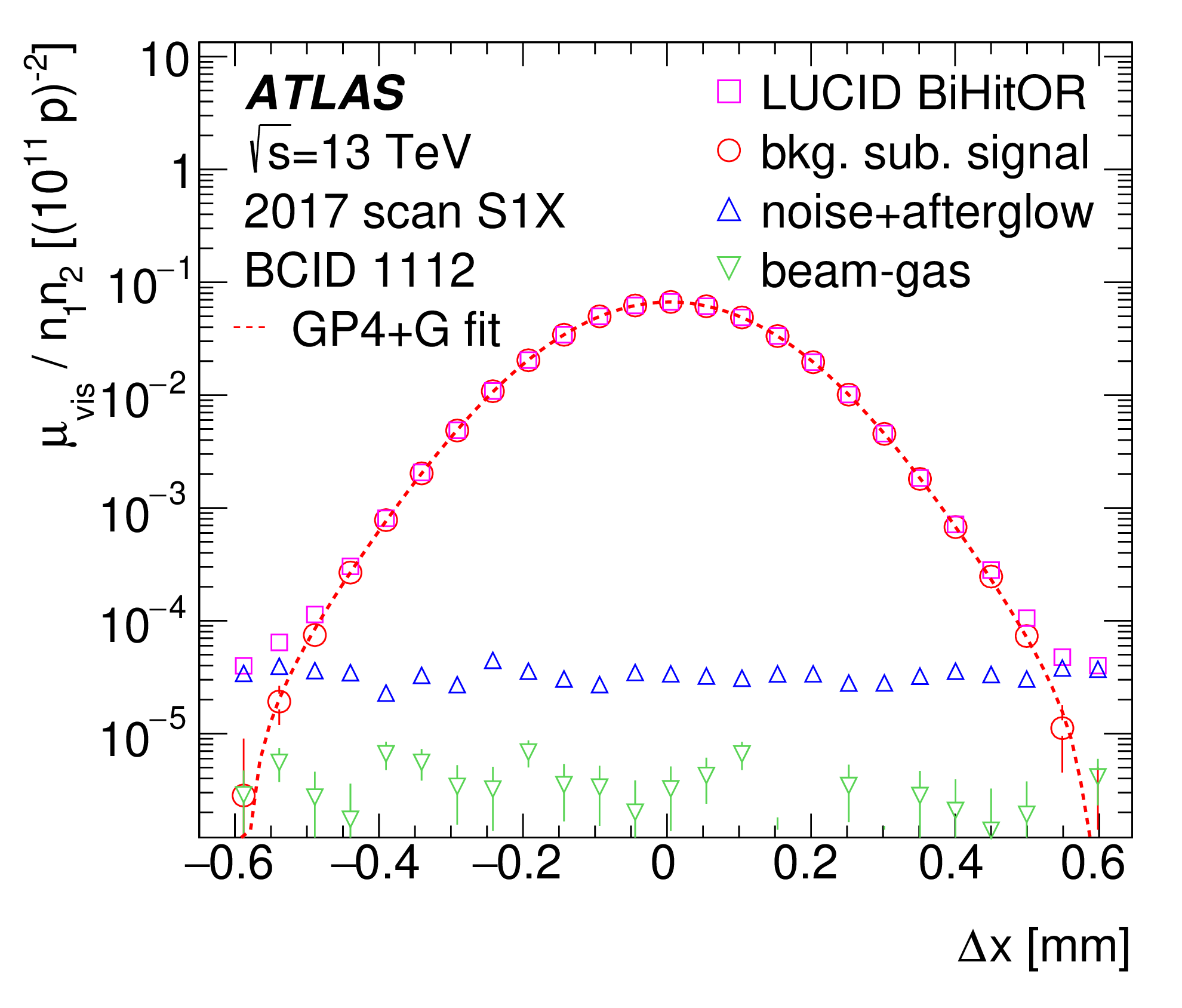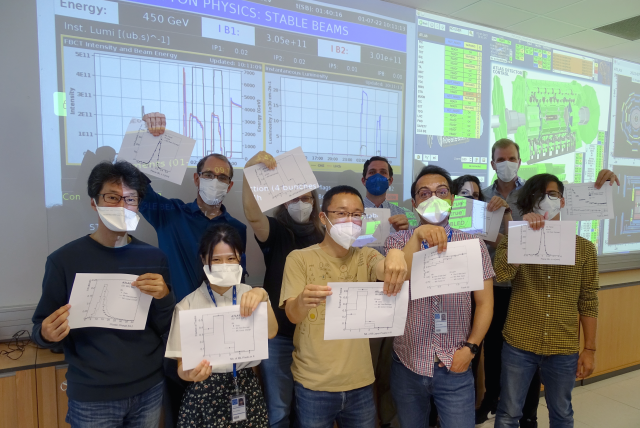Keeping the ATLAS Inner Detector in perfect alignment
16 July 2020 | By
How do you track a particle’s trajectory when your detector keeps moving? What if you find slight biases in your detector’s measurements? These were the challenges faced by the ATLAS Inner Detector during Run 2 of the LHC (2015–2018). Located at the heart of the experiment, the Inner Detector provides efficient and precise measurements of charged-particle tracks. In a new paper released today, physicists describe the complex solutions they developed to align the Inner Detector, ensuring the continued accuracy of the experiment.

The ATLAS Inner Tracking Detector is composed of three sub-detectors using different technologies: highly granular silicon pixels closest to the proton beams, followed by silicon strips and straw tubes. As charged particles traverse the detector, they leave behind a track of small energy deposits (or hits) in each sub-detector, allowing physicists to reconstruct the particle’s trajectory. Standing over 2 m tall and 6 m long, the ATLAS Inner Detector is able to measure the position of charged particles that pass through it to better than a 100th of a millimetre. To reach that precision, the detector must be aligned to equal or better accuracy.
Crucial to an accurate reconstruction is a detailed knowledge of the Inner Detector’s geometry – that is, the location and orientation of every individual sub-detector element. Detectors are far from stationary; during high-intensity LHC collisions, detector elements can shift due to fluctuations in temperature or changes in the magnetic field strength. To track these movements, ATLAS physicists regularly align the Inner Detector to determine the actual geometry of every active sub-detector element and to follow changes with time. This alignment has to be done through indirect methods, as the detector is inaccessible while the LHC is in operation.
As shown in Figure 1, there is a small difference between where a hit is recorded (red star) and the intersection of a reconstructed particle’s track with the detector plane (green dot). This is known as the track-to-hit residual, shown in the figure with blue lines. For a collection of tracks crossing an individual sub-detector, the measured residuals will be distributed randomly. If the position of a sub-detector is correctly known, the residuals will balance each other out. On the contrary, if the assumed position is wrong, physicists will notice a systematic bias in the residuals in one particular direction, indicating the misalignment of a sub-detector.
This is the basic idea behind ATLAS’ alignment algorithm. Physicists shift and rotate the assumed position of every detector element until no systematic biases in the track-to-hit residuals are observed. This is done iteratively, following the hierarchical structure of the Inner Detector. First, physicists align the large physical structures that capture the collective movements of the Inner Detector. Then they move on to aligning the individual sub-detector elements.
Detectors are far from stationary; during high-intensity LHC collisions, detector elements can shift due to fluctuations in temperature or changes in the magnetic field strength.
What do you do if your detector moves?
During Run 2 of the LHC, ATLAS researchers found that parts of the Inner Detector showed signs of short-timescale movements while recording data. A good example of this was the vertical displacement of the Pixel sub-detector, as shown in Figure 2 for an average fill of the LHC. What could be causing this movement?

The high frequency of LHC collisions saw the Inner Detector on-module readout chips saving data up to 100,000 times per second. This required a significant amount of electrical power, which in turn caused a rise in temperature at the centre of the ATLAS detector. For the Pixel sub-detector, this excess of heat would bring the sub-detector’s cooling liquid to a boil, causing a rapid change in the coolant’s mass within the detector. The sub-detector would experience significant displacements over the first hour of data-taking, until thermal equilibrium between the sub-detector and the cooling system was reached.
In time, as the intensity of the collisions decreased during a proton–proton fill of the LHC, so would the Pixel’s heat dissipation needs. The Pixel’s coolant would gradually return to its liquid form, increasing the sub-detector’s overall mass and inducing it to drift slowly in the opposite direction. This correlation between the Pixel sub-detector’s vertical position and the instantaneous luminosity (or collision rate) of the LHC is clearly visible in Figure 2.
Clearly the average position across an LHC fill does not accurately describe the sub-detector’s position! To solve this issue, ATLAS physicists had to develop a new, automated alignment scheme for the Inner Detector. This dynamic alignment would update throughout each LHC fill, calibrating the data recorded by ATLAS accordingly. New alignment constants were derived every 20 minutes during the first hour of data-taking and every 100 minutes for the rest of the fill. Figure 3 shows the evolution of the vertical positions of the innermost layer of the Pixel sub-detector, the so-called Insertable B-Layer (IBL), and the average of the other Pixel layers over a period of two months.

ATLAS developed a dynamic new alignment scheme for the Inner Detector. It would update throughout each LHC fill and calibrate the recorded data ATLAS accordingly.
How do you ensure your tracking is not biased?
Surrounding the ATLAS Inner Detector is a strong magnetic field, which bends the paths of charged particles allowing physicists to measure their momentum and charge. Ideally, a charged particle moving through an homogeneous magnetic field should follow a spiral path (helix). However, small misalignments in the Inner Detector can alter the spiral shape of the reconstructed particle’s track. While these are usually corrected for by ATLAS’ alignment procedure, there are some deformations to which the alignment algorithm is not sensitive that can bias the track’s parameters while maintaining its spiral shape.
The two most common deformations that bias the curvature (momentum) of a particle’s track are shown in Figure 4. A rotation of the detector layers (left) can cause a sagitta bias, which has opposite effects on positively and negatively charged particles. The sagitta of a circular arc is the distance from the center of the arc to the center of a line joining the two ends of the arc. The smaller the sagitta, the larger is a particle’s momentum. A radial expansion of the detector layers (right) can cause length-scale bias, affecting positive and negative particles equally. ATLAS physicists had to develop new ways to correct for these biases, independent of the alignment procedure.

Physicists turned to their data in search of a solution. Sagitta biases, for example, could be measured using any known particle that decays into a pair of stable particles. At ATLAS, this was best seen in the decay of a Z boson into a pair of oppositely-charged muons. The positive and negative muons from these decays would emerge in roughly opposite directions with, on average, the same energy. If physicists found a systematic difference in the measured momentum of the oppositely-charged muons, it would imply the presence of a sagitta bias in that region of the detector. This bias could then be measured and corrected for. The measured sagitta distortions can be seen in Figure 5, also examining their change during Run 2 of the LHC. They remained consistent, indicating a stable detector geometry throughout operation.

To correct for length-scale biases, ATLAS physicists studied the mass measurements of well-known particles, such as the J/ψ meson or the Z boson. Both of these particles decay to pairs of oppositely-charged muons, whose measured energy and direction would be impacted by length-scale biases.
Physicists developed a new method to differentiate between radial biases – which only affect the transverse component of the track – and scale biases – which affect longitudinal and transverse components in the same way. As seen in Figure 6, a radial bias would show up as a tilt of the reconstructed mass, while an offset would indicate the presence of a scale bias. ATLAS physicists found the existence of a scale bias (εs= -0.9x10-3) but no significant radial bias (εr).

Today’s new paper shows but a fraction of the work and dedication that goes into the operation of an experiment as complex as ATLAS. Physicists are now preparing the Inner Detector for its next challenge: Run 3 of the LHC which is scheduled to start in early 2022.
Links
- Alignment of the ATLAS Inner Detector in Run-2 (arXiv: 2007.07624)
- See also the full lists of ATLAS Conference Notes and ATLAS Physics Papers.



